Archive for the ‘Anusham’ Category
Bharatanatyam recital
Posted in Anusha, Anusham, Anusham Dance Group, Bharata Natyam, Dhananjayans, Kamakoti Hall, Krishna Gana Sabha, Narendra Kumar, tagged Anusha Narendra Kumar, Anusham, Anusham Dance Group, bharatanatyam, L. Narendra Kumar, Vidya Dinakaran on December 22, 2013| Leave a Comment »
My programme
Posted in Anusha, Anusham, Anusham Dance Group, Bharata Natyam, Narendra Kumar, tagged Bharata Natyam, bharatha natyam, bharathanatyam, dance, rajarathnam pillai auditorium, Vidya, vidyadinakaran vidya dinakaran on May 10, 2012| Leave a Comment »
Programme under Rasika Ranjani Sabha
Posted in Anusha, Anusham, Anusham Dance Group, Bharata Natyam, Dhananjayans, Kalakshetra, Mylapore, Narendra Kumar, R.K. Swamy Hall, Rasika Ranjani Sabha, Sivasamy Kalalaya School, tagged Mylapore, R.K. Swamy Hall, Rasika Ranjani Sabha, Sivasamy Kalalaya on October 25, 2010| Leave a Comment »
Invitation
Posted in Anusha, Anusham, Anusham Dance Group, Bharata Natyam, Narendra Kumar, Uncategorized on May 26, 2010| Leave a Comment »
Invitation for my programme
Posted in Anusha, Anusham, Anusham Dance Group, Bharata Natyam, Dhananjayans, Kalakshetra, Narendra Kumar, Shanta Dhananjayan, V.P Dhananjayan, tagged Mylapore, programme, R.K. Swamy Hall, Sri Parthasarathy Sabha, Sri Parthasarathy Swamy Sabha on February 1, 2010| 1 Comment »
I am performing under the auspices of Sri Parthasarathy Swamy Sabha in Mylapore on February 9, 2010 at 5.45 p.m. Please treat this as a personal invitation.
Anusham Dance Group
Posted in Anusha, Anusham, Anusham Dance Group, Bharata Natyam, Dhananjayans, Kalakshetra, Narendra Kumar, Shanta Dhananjayan, V.P Dhananjayan, tagged Anusha, Anusha Narendra, Anusha Narendra Kumar, Anusha Narendrakumar, Anusham, Anusham Dance Group, Bharat Kalachar, Bharata Natya, Bharata Natyam, Bharatanatya, bharatanatyam, bharatanatyam classes, Chennai, Courses, dance, dance classes, dance group, Dhananjayan, Dhananjayans, India, Kalakshetra, L. Narendra Kumar, L. Narendrakumar, Shanta Dhananjayan, The Dhananjayans, Vidya, Vidya Dinakaran on January 2, 2010| Leave a Comment »
THE GURUS
Narendra Kumar is an early student of the Dhananjayans. He has earned a name for himself as a skilled Bharata Natyam dancer and choreographer. Eager to explore different dimensions in dance, he has studied martial arts such as Kalaripayyattu, Silambam and Tai-Chi. He has his dance establishment Anusham and is a teacher, choreographer and performer, along with his wife Anusha. He travels to the US often to work with dancers/choreographers and to aid them in their productions.
Anusha Narendra Kumar
Anusha Narendra Kumar is a disciple of the Dhananjayans and is well known as an excellent exponent of Bharata Natyam. She is the wife of Narendra Kumar and they are gaining a reputation as a skilled dancing couple. She is a teacher in their school “Anusham” and they also work with dancers in the US conducting classical dance workshops and assisting in choreography. She won audience appreciation and critical acclaim for her performance in Living Tree. She is also earning a name as a fine visual artist.
Click here to read the article by Samanth Subramanian about L. Narendra Kumar in the Sunday Magazine section of The New Indian Express
Art knows no barriers
Posted in Anusha, Anusham, Anusham Dance Group, Bharata Natyam, Narendra Kumar on June 28, 2009| Leave a Comment »
An article by SAVITHA GAUTAM in THE HINDU that features my Gurus
Artists from three continents came together for ‘Shifting Grounds’, a music-dance creation, performed in Germany.
CULTURAL RENDEZVOUS: The dancers who participated in ‘Shifting Grounds.’ On the extreme right are my Gurus Anusha and Narendra Kumar
Lalgudi G.J.R. Krishnan is bubbling with excitement these days. The reason? His recent success in Germany where he participated in ‘Shifting Grounds,’ a music-dance production put together by the University of Cologne under the leadership of producer Prof. Dr. Hans Neuhoff of the Cologne University.
The shows, held during May in three German cities (Cologne, Düsseldorf and Aachen), were supported by DAAD (German Academic Exchange Service).
“This is the first time, musicians and dancers from three continents — Asia, Africa and Europe — have pooled their talent to create a production that talks of life, human emotions and the art of communication,” says Krishnan, sitting in his T. Nagar home.
‘Shifting Grounds’ is the culmination of one and a half years of intense discussions and two months of rigorous rehearsals. Eight 90-minute shows were presented with 20 artists from Europe, West Africa (Senegal and Burkina Faso) and India (most of them were in Germany under the DAAD Fellowship programme) showcasing their talent.
The team
The production was conceptualised and produced by Hans, while music was composed by fellow professor and pianist Paulo Alvares and choreographed by Vera Sanders, also from the Cologne University.
The Indian flavour was provided by Krishnan and his violin, Ghatam V. Suresh, and dancers Anusha, Narendra Kumar and Sangeeta Isvaran.
On the genesis of the project, Hans in a telephonic conversation, explains, “The theme has its roots in the RASA theory of the Indian arts. It deals with the basic emotions of Man which can be expressed in many ways and yet, is universal. ‘Shifting Grounds’ is also about trans-cultural communication where non-verbal art forms are effectively employed to convey human emotions.”
Paulo shares similar thoughts. “The key words in this production are ‘contrasting’ and ‘shifting.’ ‘Contrasting’ because in the beginning, everything is so different — the styles, the traditions and even the language of expression. But finally, there is only one thought, one emotion. ‘Shifting’ because the styles literally move from one to the next in a smooth, harmonious manner.”
The stage for ‘Shifting Grounds’ was shared by two pianos, a violin and various percussion instruments.
The music was an eclectic mix of Western classical notes, Carnatic ragas and African rhythms. Says Paulo, “Believe me, we did not have a score at all! The music was in my mind. I allowed each musician the freedom to explore within a framework. That’s how the music evolved.” Paul, not familiar with Indian music till then, discovered “new sounds, rich cultures and different ways of thinking musically.”
The ragas represented
Talking about his musical contribution, Krishnan says, “I played snatches of such grand ragas as Varali, Vachaspati (‘Hans specifically requested it’), Revagupti and Kalyanavasantham. The Vachaspati raga alapana was the longest at 10 minutes! The raga suited the mood of the dance movements which express peace and calm.”
Hans, who studied under Lalgudi Jayaraman years ago, says, “Krishnan’s piece was the only sustained melodic sound in the whole production. his playing has won him many fans.”
For both Krishnan and Suresh, the German sojourn was a fun-filled learning experience.
Recalls Krishnan, “On the first day of the rehearsal, I did not know anybody except fellow Indians. Also, most of the others did not know English. But once I picked up my violin and played, the differences simply faded. Clichéd it may be, but music truly transcends barriers.”
Suresh adds, “There were some instruments which I had never seen before. Similarly, the African drummers were curious about the ghatam and the thavil. During the two months we were there, we were like one big family.
“In fact, Krishnan and I had to share an apartment with Fatou Cisse, a singer from Senegal. We had a fabulous time, trying out new recipes and learning French words. And yes, we taught her Tamil words.”
Talking about her role, Vera Sander says, “I spent two weeks in India trying to understand the various classical dance forms. I learnt about the mathematical precision, rhythm patterns and phrasing of Indian dances as also the strong link between dance and music.”
Her challenge was to create something which linked diverse styles without losing the distinct identity of each. “It was quite a challenge because we had to move away from the individual and find a common ground. In the end, what mattered was how effectively the movements conveyed the emotions…”
Will ‘Shifting Grounds’ find an Indian audience? Hans rues, “It is an expensive proposition. I do hope to take it to other parts of the globe.” But how? That remains to be seen.
(This article appeared in the Friday Review of The Hindu dated June 19, 2009)
Anusham’s Shakti: Review and pictures
Posted in Anusha, Anusham, Bharata Natyam, Narendra Kumar, tagged Anusha, Anusha Narendra, Anusha Narendra Kumar, Anusham, Anusham Dance Group, Bana Ramnath, Dhananjayans, Gayathri Mantra, Kavita Venkateswar, L. Narendra Kumar, Mahalakshmi Ashtotram, Mantra Pushpam, Narendra Kumar, Rupa Srikanth, Saraswati sloka, Shakti, shodasopachara puja, The Hindu, The Hindu Friday Review on June 1, 2008| Leave a Comment »
RUPA SRIKANTH
The Anusham group presented `Shakthi,’ with perfect co-ordination, accurate timing and discipline.
L. Narendra Kumar first shot to fame some years ago with an exciting group choreography of the Kalinga Narthana tillana. Since then, he has remained on the horizon, stretching the boundaries of art and choreography with varying degrees of success.
This season, Anusham group, led by Narendra Kumar and Anusha, presented `Shakthi,’ a thematic work on the Mother Goddess.
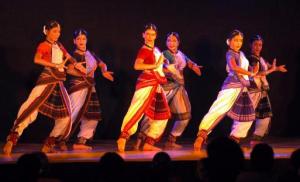
The endeavour was to present a traditional idea with predominantly traditional hymns, from a non-traditional perspective. That’s why the presentation differed in form, but not in content.
With the total absence of narrative, symbolism was the operative tool of communication. It was a contradiction in terms, really because this choreography celebrated the sheer physicality of movement without detracting from the seriousness of the imagery.
It is always a risk to employ devotional prayers, but in the present case, the choreographers came out unscathed simply because they did not tamper with the aura of solemnity.
The Gayathri Mantra, the Saraswati sloka, the Mahalakshmi Ashtotram, the step-by-step shodasopachara puja and the Mantra Pushpam were used in different parts of the presentation, each properly recited and sensitively captured in a visual medium.
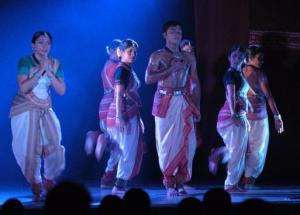
Besides an opening homage to Gayathri Devi, the manifestations of Shakti as Durga, Lakshmi and Saraswati formed the core illustrations.
The dancers — Anamika, Poornema, Vidya Madhubala, Vidyalakshmi, Gayathri, Tiruchelvam, Guhendran, Narendra Kumar and Anusha — dressed in simple white cotton costumes and adorned with silver jewellery, excelled with their perfect co-ordination, accurate timing and discipline. The tightly-knit choreography was bound together by crisp passages of nritta, not dramatically stirring, yet effective in their very precision.
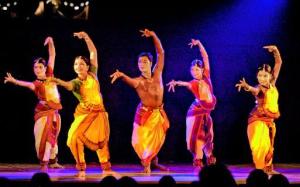
Poetic resonance
Moments of poetic resonance and friezes were pegged efficiently by the additional lighting by Nambu Kumar.
The music composition and the veena accompaniment were by Rajhesh Vaidya, the konnakkol and sollus by L. Narendra Kumar, percussion by N. K. Kesavan and Sudaman and vocal by Haricharan and Bhavatharini. Within the framework of the production, there were winds blowing from different directions. The Shakthi Kauthuvam composed by S. Guhendran juxtaposed the divine mother and her mortal counterpart in finely crafted wording. The same theme replayed through a poignant
A.R. Rehman composition, “Uyirum Neeye” conveyed the essence of the production in a powerful finale.
While the gurus’ generosity can be appreciated, it was a disappointment for the audience when Narendra Kumar and Anusha’s disciple, Kavita Venkateswar, took centre stage that evening to present a full margam before the staging of `Shakthi.’ The 15-year-old from San Antonio is also a disciple of Bana Ramnath and the Dhananjayans, and is a good dancer, bright-faced and lively.
The lilting Lathangi varnam in Adi talam, a composition of Madurai R. Muralidharan brought out Kavita’s felicity with story telling and rhythm.
She requires some changes in posture though. Definitely a student to be proud of.
Narendra Kumar featured in an article
Posted in Anusha, Anusham, Bharata Natyam, Kalakshetra, Narendra Kumar, tagged Chinnamanoor, Dhananjayan, J. Guru Prasad, J. Krishna Kumar, male dancers, New Indian Express, Samanth Subramaniam, Sunday Magazine on May 15, 2008| 1 Comment »
Nataraja’s Children
by Samanth Subramanian
(Article appeared in The New Indian Express, Sunday Magazine)
Narendra Kumar likes putting things in comparative ratios; they pop up throughout his conversation. For every 100,000 people enthusiastically watching movies, there are just 10 similarly devouring classical Bharatanatyam. For every two months of hectic seasonal work, there are six months of scraping-by subsistence. For every 100,000 trained female Bharatanatyam dancers in Chennai, there are 40 competent men – of which, Narendra estimates, only eight or ten are truly professional dancers. Comparative ratios have never looked bleaker. It’s a tough life, but somebody’s got to live it.
Narendra does – emphatically. One hour before a show, he hasn’t even entered the green room. He still stands on stage, producer-director-choreographer-dancer merged into one, deciding where the smoke machines should go, cueing music for last-minute rehearsals, watching moves out of the corner of his eye even as he speaks to the light-and-sound men, nudging members of his troupe Anusham to get dressed, worrying about the feeble voltage, limbering up almost unconsciously himself.
He’s also fretting silently. “Only yesterday, we found out that we were required to perform for two hours. We’ve been rehearsing a one-hour show for three weeks now,” he says. For three weeks of practice, three or more hours a day, the payoff isn’t spectacular; Anusham will get Rs 8,000, and after paying for lights and costumes, Narendra will be left with Rs 1,500. “I still try to pay my dancers, even if it isn’t a grand amount,” he says. “They’ve paid for autos and buses to come every evening to rehearse, so it’s only right that they get something in return.”
WALK OF LIFE
When he was learning to dance himself, Narendra took no autos or buses. Living in a flat the size of a matchbox, with both his brother and father out of work, Narendra had just passed out of school when he enrolled to study under the renowned VP Dhananjayan. His interest in dance was almost congenital; even before the age of five, when he heard music, he would involuntarily move to its rhythm. When he then began taking classes, he was further drawn to the grace and beauty of Bharatanatyam.
“When I started learning under Dhananjayan sir, financially we were in a very sad situation. So I walked to dance class,” he says – from Villivakkam to Adyar, six days a week, three and a half hours every morning and three and a half hours every evening, with eight hours of dance in between. On the seventh day, he hardly rested; without the knowledge of the other students, he crept into the classroom to clean and mop the floor. “Dance was my life. I would have done anything for it.”
It is the sort of situation, says 30-year-old Narendra, that many young male dancers find themselves in now. “Today, men from the middle- and upper middle-class take up dance just as a hobby, and they get into other, more lucrative careers,” he says. “Almost all the really committed, disciplined male dancers come from poor backgrounds, with fewer educational and professional options in front of them. They’re the ones who have the fire in the belly, the passion.”
Dhananjayan has noticed a similar demographic shift. Long acclaimed as the man who put masculinity back into male Bharatanatyam, he began his own career in straitened circumstances, and he knows what he’s seeing. “It’s all thanks to the economic renaissance,” he says. “Earlier, in Kerala for example, even the rich Namboodris used to seriously pursue Kathakali.” Today, though, there are suddenly professions out there that can pay – literally – a thousand times better, so only the educationally and financially disadvantaged look to dance to haul themselves upwards.
J Guru Prasad and J Krishna Kumar – unrelated, shared initial notwithstanding – illustrate that well. With an ancestral phalanx of chartered accountants behind him, Guru Prasad never once entertained the idea of dancing as a career, even though he learned the art for 15 years. “The CA was always my goal,” he says. “Dance had much less career security, and by the time I was even aware that it was a possible profession, I was 24 or 25. Much too late to start then.”
Krishna Kumar, from the village of Chinnamanoor in Tamil Nadu, took the road less travelled. His father refused to support his dance lessons, so he worked as an attendant at a hospital to pay his fees. “I carted boxes, handed out injections, did odd jobs. Out of the Rs 250 I earned every month, I paid Rs 200 for dance tuitions,” he says. When he read about the Kalakshetra dance academy in Chennai, he performed a different type of penance every day – “hunger one day, standing in the sun the next, and so on” – until his parents relented and allowed him to join.
DIRE STRAITS
When he emerged from Kalakshetra four years later, though, Krishna Kumar drew a blank. Even today, decades after Dhananjayan burst onto the scene, it is difficult for male dancers to forge solo careers. “It is the same with classical dance everywhere,” says Dhananjayan. “Earlier we had great male artistes like Uday Shankar, Ram Gopal, Govinda Gopal and Guru Gopinath, but with the exception of Gopinath, all the rest had to establish themselves abroad first.” Despite his own successes, Dhananjayan says, “Bharatanatyam is still regarded by many as a female art.”
That is not necessarily the case elsewhere in India. Leela Samson, the current director of Kalakshetra and a dancer who has worked all over the country, points to Manipuri, Kathakali and Kathak as examples of dances that are dominated by men. Even in Bharatanatyam, she says, the men don’t need to get disheartened. “Look at Kelucharan Mahapatra. He revived Odissi, but only towards the tail end of his career, when he was 55 or so, was he recognised as an amazing performer,” she says. “It didn’t worry him, and it shouldn’t worry the current batch. In fact, we have it better in India; elsewhere in the world, ballet dancers are struggling to even survive. Dance may be a particularly tough field, but it all depends on the work you do.”
Even if there are more difficulties today, Dhananjayan won’t agree that his generation had it significantly easier. “There are other avenues to explore now,” he says. “There are more companies willing to come forward as sponsors; there are more parents who want their children to learn.” MV Narasimhachari, president of the Association of Bharatanatyam Artistes of India (ABHAI) and a contemporary of Dhananjayan, cites exactly those two routes to a sustainable dance career. “They simply must learn, along with the art, how to promote themselves well.”
Narendra took one of those two routes. When he isn’t rehearsing classical Bharatanatyam, he stages shows for corporate events, incorporating athletic arts like Kalaripayattu and using lighter, livelier music. “When I had to add another hour to this show, I was forced to bring in some of those numbers,” he says almost regretfully. And yet these corporate events put food on the table and money into his dancers’ pockets, and Narendra realises it.
When he hears that Dhananjayan has extolled today’s plentiful opportunities, he smiles wanly, and like a good shishya, he does not contradict his guru directly. Instead, almost gently, he says: “I know many male dancers who cannot even eat three meals a day.” He points to one of his own dancers practicing off to one side of the rehearsal space. Thiruchelvan came to Chennai from Sri Lanka just to learn dance, and Narendra says he survives solely on passion.
A little further up the ladder are the overseas tours, but far from being extravagant junkets, they are compressed capsules of maddeningly hard work. “On an upcoming tour, travelling all the while, we are going to be doing 10 shows in the first 10 days,” says Narendra. It will be his 15th trip to the US in almost as many years. For those three months of touring, he points out, lapsing again into the comparative ratio, there needs to be one year of preparation. “So even if we do earn $5,000 at the end of it all, that’s actually for 15 months of work, not three.”
SO FAR AWAY
Fresh out of Kalakshetra, Krishna Kumar heard about a teaching position at a school in Vellore, and with little else on hand, he accepted it. Ten years later, he’s still at it; every weekend, he travels to Vellore to tutor a student body that has grown to a strength of 100. Like Narendra, he is proof that it is possible to survive – just about – in this profession. “I came to Chennai to be a big dancer,” says Krishna Kumar. “But when I had to struggle to make ends meet, I had to accept it. That desire is still there, but when you realise that you just cannot become big, you have to live with that fact.”
Narasimhachari won’t have any of it. “They should stop complaining,” he says; there’s a smile on his face, but his voice is stern. “There is too much of a hunger for opportunities today, and too much complaining if they don’t come along. People are always looking for the next chance to go to London or America, when they should really be working harder on their art. If you get to a certain level of excellence, merit will tell. Talent will tell.”
He admits, though, that audiences are dwindling; even for his performances, well known as he is, he says he can’t pack the halls. At Narendra’s show, the auditorium is barely two-thirds full. The performance wends a smooth enough way to its conclusion. The first half, a package titled Shakti, is admirably creative and admirably danced. The second half, even if it isn’t marred by glaring missteps, looks exactly like what it is – a hastily tacked-on 60 minutes, completely divergent in tone and appeal from what came before.
To the smattering of audience that drifts backstage to congratulate the dancers, Narendra is his usual genial, slightly shy self. His torso is still slick with sweat, and he hasn’t yet changed out of his costume. He will leave the venue only an hour later, after reverting to his producer-director self, supervising packing up, settling dues, making sure the girls have rides home, making sure nothing is left behind in the green rooms. Then he will get on his bike, richer by Rs 1,500, and drive back home. He lives for what he does, though, and he doesn’t have to walk 25 kilometers home every day. Perhaps there’s something to be said for that.
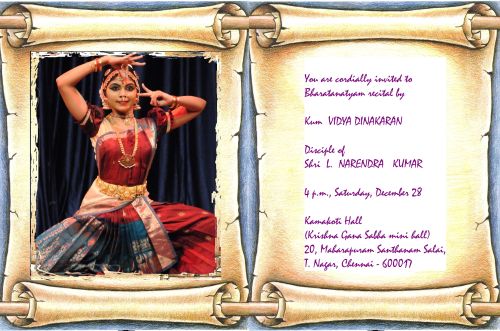





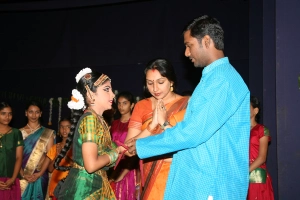
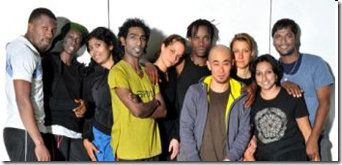

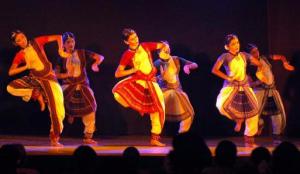

You must be logged in to post a comment.